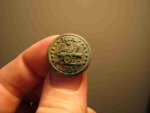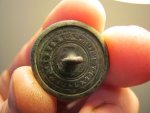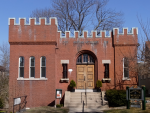Mark kus
Well-known member
Very cool piece of history this button dates 1860-1865 but the Kentish Guard were formed in 1774 and were a elite force Washington used 35 members in his Continental Army !
Here is a article on them very interesting story full of New England history.
Home About Us The Armory Personnel Fife & Drum Corps Calendar Photo Gallery Contact Us
Kentish Guards History
Revolutionary War
The Kentish Guards were formed on September 24, 1774 to protect the Town of East Greenwich, Rhode Island from Tory attack. They were chartered by the Colonial Assembly on October 29, 1774 as an "elite militia," taking extra responsibility for their own training and equipment. Using the Kent County Court House as their armory, the Kentish Guards were present when the Rhode Island Navy was enacted there in 1775. They built Fort Daniel at the entrance to Greenwich Cove in Cowesett, equipped it with nine cannons, and garrisoned it throughout the Revolution., protecting Warwick Bay from naval attack.
The Guards were also present at the formation of the Continental Army during the Siege of Boston in 1775, where General Washington noticed how exceedingly well the Kentish Guards were trained, equipped, and disciplined. Thirty-five members of the Guards were subsequently to serve as officers in the Continental Army, foremost among them Major General Nathanael Greene, the "Savior of the South" who, by the end of the war, was second only to Washington.
Initially the Guards rotated state duty with other militia companies; but with the British invasion of Newport in 1776, they were on continuous duty from May 1, 1776 to June 1, 1781. They patrolled Warwick Neck, Prudence Island, Warren, Bristol, Tiverton, Portsmouth, Middletown and Newport. In the summer of 1776 the Guards recaptured a ship previously seized by the British Navy. During this engagement they suffered their only casualty; Edward Pearce was shot in the arm and the arm had to be amputated. Always keeping a detachment at Fort Daniel, they were the sole defenders of East Greenwich in 1777 and 1778, and countered several attacks launched on Potowomut and Warwick Neck (to the East), and Quidnessett and Wickford (to the South).
In August 1778 Kentish Guards Commander, Colonel Richard Fry, took command of a regiment of Independent Militia Companies at the Battle of Rhode Island in Portsmouth and Middletown. During the summer of 1779, twenty-six Guardsmen launched a surprise attack on Conanicut Island (Jamestown), destroying a British artillery battery. In November, after the British evacuated Newport, the Guards were ordered to guard duty at Sachuest (Second) Beach to help prevent a British return.
The Guards were again ordered to Newport in 1780 and 1781 to reinforce the travel-weakened French Army, and were present in Newport during General Washington's visit there. After the war, the Kentish Guards continued to provide local defense when many other militia companies were disbanded or became volunteer fire departments. During this period, even the United States Army and Navy were temporary disbanded.
War of 1812
In 1807 all of the officers of the Kentish Guards were court-marshaled. The commander, Colonel David Pinnegar, was ordered to select six Guardsmen to be drafted for federal service; Colonel Pinnegar believed that the Kentish Guards Charter allowed for the call up of the whole unit for state duty, but not for drafting individual members for federal service. Colonel Pinnegar and all the other line officers were removed from office without any further penalty in a politically controversial trial. But the Guards continued under new officers. They served guard duty at the old Fort Adams in Newport during the War of 1812.
The Dorr Rebellion
In 1842 a state constitutional crisis brought about the existence of two rival state governments, one operating under the charter granted by Charles II in 1663, and the other, a reform government led by Thomas Dorr. Both parties sought to avoid conflict, but Dorrite hotheads attempting to seize a state armory in Providence sparked a confrontation on May 17th. The "Charter Government" called out the militia, ending the rebellion in a bloodless battle the following day in Providence. The Kentish Guards received the call to arms personally from Adjutant General Elisha Dyer, who had disguised himself and gone to East Greenwich in a wagon during the night. The train that was to transport them to Providence had been interdicted by the Dorrites, so the Guards marched to Providence. Missing the initial battle, they were then called to quell a dangerous riot in Pawtucket on June 27th, which turned out to be the bloodiest and most difficult engagement of the Dorr War. Here Kentish Guards Commander, Colonel George Allen, took charge of six militia companies besides the Guards, halting a mob preparing to attack Pawtucket and restoring order (picture the recent movie, Gangs of New York). In gratitude for their services, the state gave the Guards a grant of one thousand dollars, with which they built their current armory on the corner of Peirce and Armory Streets in East Greenwich in 1843.
The Civil War
During the Civil War, the Kentish Guards enlisted as Company "H" of the 2nd Rhode Island Volunteers on 5 June 1861. They saw extensive service in the Peninsular Campaign in Virginia with the Army of the Potomac and fought in 14 major battles of the Civil War. The 2nd Rhode Island distinguished itself covering the retreat of the Union Army at the First Battle of Bull Run, one of only three regiments to hold their ground in this battle, and again in the Battle of the Wilderness, being the last unit out. The 2nd Rhode Island was a primary focus of the television series by Ken Burns on the Civil War based on the memoirs of Elisha Hunt Rhodes. The Kentish Guards also recruited and supplied the officers for Company "H" 7th Rhode Island Volunteers on 22 May 1862 and saw service with the Army of the Potomac and Army of the Ohio. LEARN MORE
Spanish-American War
The Guards were last on alert during the Spanish-American War when the Spanish Navy menaced the East Coast of the United States. At the turn of the Twentieth Century they declined the offer to joint the National Guard system then being formed. The Kentish Guards chose to continue under their old charter under which they elect their own officers and have control of their own affairs.
Present Day
Kentish Guardsmen have since participated in all the major wars of the twentieth century in federal service. They continue under their charter and the laws of the state of Rhode Island, and are subject to its good regulation, including inspection by the Adjutant General and the command of the Governor. On call for local emergencies, Guardsmen patrolled the hurricane-damaged waterfront in 1956, and controlled traffic during the town's tercentennial in 1977. They were most recently activated by the Governor in 1994 for ceremonial duties connected with the commissioning of the USS Rhode Island.
The Kentish Guards participate in the annual state-run cannon and musket qualification and competition that is held for all the militia companies. They are often called upon on by state, civic, and educational organizations for patriotic, historical, educational, and ceremonial duties.
Fife and Drum Corps
In 1774 the Kentish Guards had two fifers and two drummers, appropriate for a company-sized organization. They had a military band from 1937 to 1977, which in its day was one of the premier musical organizations in the state. In 1966 they organized a regimental-sized fife and drum corps. The Fife and Drum Corps continues as one of the leading corps in the nation.
Kentish Guards Uniform
The 1774 uniform of the Guards was a red coat with green facings and silver trim, with a white vest and pants styled after the English military model. At the beginning of the Revolution Rhode Island, having a locally elected charter government, was wealthy (from smuggling). As a result, Rhode Island's militia could afford to be fully uniformed, unlike the Minutemen of Massachusetts who were oppressed by the Royal Governor. Since then, the Guards have worn a succession of military uniforms based on the styles of the day.
The current parade uniform is based on the uniform worn by the Guards between the 1790's and just before the War of 1812. It is a dark blue coat with red lapels and white trim, with white false-turnbacks on the coat tails. The vest is white, the pants a dark blue with red piping, as are the leggings. A bear fur crested light infantry helmet is worn by the militia company. The Fife and Drum Corps wears the same uniform except for black "bicorn" hats with black cockades fasted by a brass "KG" button. These would have been appropriate for the period.
Company Flag
The Kentish Guards company flag has a white field, which represents Rhode Island. The canton in the upper left corner is red with a federal eagle, sixteen stars and stripes, and the Rhode Island anchor. It was adopted between 1796 and 1803.
Here is a article on them very interesting story full of New England history.
Home About Us The Armory Personnel Fife & Drum Corps Calendar Photo Gallery Contact Us
Kentish Guards History
Revolutionary War
The Kentish Guards were formed on September 24, 1774 to protect the Town of East Greenwich, Rhode Island from Tory attack. They were chartered by the Colonial Assembly on October 29, 1774 as an "elite militia," taking extra responsibility for their own training and equipment. Using the Kent County Court House as their armory, the Kentish Guards were present when the Rhode Island Navy was enacted there in 1775. They built Fort Daniel at the entrance to Greenwich Cove in Cowesett, equipped it with nine cannons, and garrisoned it throughout the Revolution., protecting Warwick Bay from naval attack.
The Guards were also present at the formation of the Continental Army during the Siege of Boston in 1775, where General Washington noticed how exceedingly well the Kentish Guards were trained, equipped, and disciplined. Thirty-five members of the Guards were subsequently to serve as officers in the Continental Army, foremost among them Major General Nathanael Greene, the "Savior of the South" who, by the end of the war, was second only to Washington.
Initially the Guards rotated state duty with other militia companies; but with the British invasion of Newport in 1776, they were on continuous duty from May 1, 1776 to June 1, 1781. They patrolled Warwick Neck, Prudence Island, Warren, Bristol, Tiverton, Portsmouth, Middletown and Newport. In the summer of 1776 the Guards recaptured a ship previously seized by the British Navy. During this engagement they suffered their only casualty; Edward Pearce was shot in the arm and the arm had to be amputated. Always keeping a detachment at Fort Daniel, they were the sole defenders of East Greenwich in 1777 and 1778, and countered several attacks launched on Potowomut and Warwick Neck (to the East), and Quidnessett and Wickford (to the South).
In August 1778 Kentish Guards Commander, Colonel Richard Fry, took command of a regiment of Independent Militia Companies at the Battle of Rhode Island in Portsmouth and Middletown. During the summer of 1779, twenty-six Guardsmen launched a surprise attack on Conanicut Island (Jamestown), destroying a British artillery battery. In November, after the British evacuated Newport, the Guards were ordered to guard duty at Sachuest (Second) Beach to help prevent a British return.
The Guards were again ordered to Newport in 1780 and 1781 to reinforce the travel-weakened French Army, and were present in Newport during General Washington's visit there. After the war, the Kentish Guards continued to provide local defense when many other militia companies were disbanded or became volunteer fire departments. During this period, even the United States Army and Navy were temporary disbanded.
War of 1812
In 1807 all of the officers of the Kentish Guards were court-marshaled. The commander, Colonel David Pinnegar, was ordered to select six Guardsmen to be drafted for federal service; Colonel Pinnegar believed that the Kentish Guards Charter allowed for the call up of the whole unit for state duty, but not for drafting individual members for federal service. Colonel Pinnegar and all the other line officers were removed from office without any further penalty in a politically controversial trial. But the Guards continued under new officers. They served guard duty at the old Fort Adams in Newport during the War of 1812.
The Dorr Rebellion
In 1842 a state constitutional crisis brought about the existence of two rival state governments, one operating under the charter granted by Charles II in 1663, and the other, a reform government led by Thomas Dorr. Both parties sought to avoid conflict, but Dorrite hotheads attempting to seize a state armory in Providence sparked a confrontation on May 17th. The "Charter Government" called out the militia, ending the rebellion in a bloodless battle the following day in Providence. The Kentish Guards received the call to arms personally from Adjutant General Elisha Dyer, who had disguised himself and gone to East Greenwich in a wagon during the night. The train that was to transport them to Providence had been interdicted by the Dorrites, so the Guards marched to Providence. Missing the initial battle, they were then called to quell a dangerous riot in Pawtucket on June 27th, which turned out to be the bloodiest and most difficult engagement of the Dorr War. Here Kentish Guards Commander, Colonel George Allen, took charge of six militia companies besides the Guards, halting a mob preparing to attack Pawtucket and restoring order (picture the recent movie, Gangs of New York). In gratitude for their services, the state gave the Guards a grant of one thousand dollars, with which they built their current armory on the corner of Peirce and Armory Streets in East Greenwich in 1843.
The Civil War
During the Civil War, the Kentish Guards enlisted as Company "H" of the 2nd Rhode Island Volunteers on 5 June 1861. They saw extensive service in the Peninsular Campaign in Virginia with the Army of the Potomac and fought in 14 major battles of the Civil War. The 2nd Rhode Island distinguished itself covering the retreat of the Union Army at the First Battle of Bull Run, one of only three regiments to hold their ground in this battle, and again in the Battle of the Wilderness, being the last unit out. The 2nd Rhode Island was a primary focus of the television series by Ken Burns on the Civil War based on the memoirs of Elisha Hunt Rhodes. The Kentish Guards also recruited and supplied the officers for Company "H" 7th Rhode Island Volunteers on 22 May 1862 and saw service with the Army of the Potomac and Army of the Ohio. LEARN MORE
Spanish-American War
The Guards were last on alert during the Spanish-American War when the Spanish Navy menaced the East Coast of the United States. At the turn of the Twentieth Century they declined the offer to joint the National Guard system then being formed. The Kentish Guards chose to continue under their old charter under which they elect their own officers and have control of their own affairs.
Present Day
Kentish Guardsmen have since participated in all the major wars of the twentieth century in federal service. They continue under their charter and the laws of the state of Rhode Island, and are subject to its good regulation, including inspection by the Adjutant General and the command of the Governor. On call for local emergencies, Guardsmen patrolled the hurricane-damaged waterfront in 1956, and controlled traffic during the town's tercentennial in 1977. They were most recently activated by the Governor in 1994 for ceremonial duties connected with the commissioning of the USS Rhode Island.
The Kentish Guards participate in the annual state-run cannon and musket qualification and competition that is held for all the militia companies. They are often called upon on by state, civic, and educational organizations for patriotic, historical, educational, and ceremonial duties.
Fife and Drum Corps
In 1774 the Kentish Guards had two fifers and two drummers, appropriate for a company-sized organization. They had a military band from 1937 to 1977, which in its day was one of the premier musical organizations in the state. In 1966 they organized a regimental-sized fife and drum corps. The Fife and Drum Corps continues as one of the leading corps in the nation.
Kentish Guards Uniform
The 1774 uniform of the Guards was a red coat with green facings and silver trim, with a white vest and pants styled after the English military model. At the beginning of the Revolution Rhode Island, having a locally elected charter government, was wealthy (from smuggling). As a result, Rhode Island's militia could afford to be fully uniformed, unlike the Minutemen of Massachusetts who were oppressed by the Royal Governor. Since then, the Guards have worn a succession of military uniforms based on the styles of the day.
The current parade uniform is based on the uniform worn by the Guards between the 1790's and just before the War of 1812. It is a dark blue coat with red lapels and white trim, with white false-turnbacks on the coat tails. The vest is white, the pants a dark blue with red piping, as are the leggings. A bear fur crested light infantry helmet is worn by the militia company. The Fife and Drum Corps wears the same uniform except for black "bicorn" hats with black cockades fasted by a brass "KG" button. These would have been appropriate for the period.
Company Flag
The Kentish Guards company flag has a white field, which represents Rhode Island. The canton in the upper left corner is red with a federal eagle, sixteen stars and stripes, and the Rhode Island anchor. It was adopted between 1796 and 1803.






